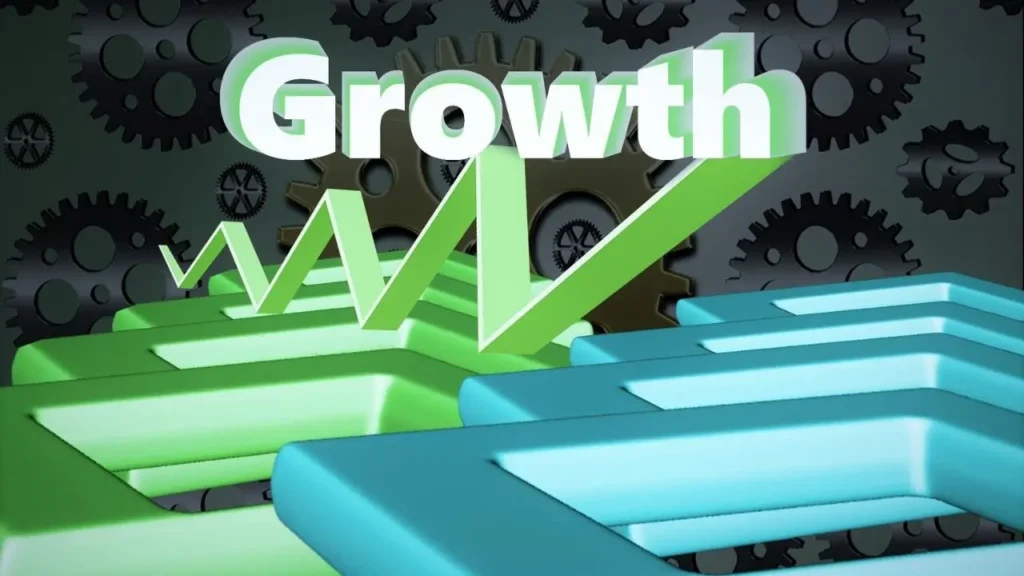
Economic growth is a fundamental objective of any economy, it refers to the increase in production and economic wealth available in the country. It is measured on a national scale and with the tools of national accounting
It is the perpetual quest for economic policies pursued by governments. It is essential for society to the extent that it helps to increase the standard of living of the population, and to address many economic and social problems such as unemployment.
How is economic growth defined?
Annual economic growth corresponds to the sustained and sustainable increase in the production of goods and services. This positive variation is measured by the annual evolution of a wealth indicator, namely the Gross Domestic Product (GDP), unlike expansion which is a short-term increase.
Economic growth in economics quantifies the change in the production of goods and services in an economy over a given period of time. It therefore corresponds to the increase, over a long period, in the volume of production and wealth of a country.
Meaning of economic growth
The term growth is often used to refer to periods when GDP increases. However, a slowdown in the growth rate corresponds to a period of recession.
It should be noted that the growth rate corresponds to the rate of change between the gross domestic product (GDP) at the beginning of the period and the GDP at the end of the period considered. Growth is therefore expressed as a percentage.
Moreover, the increase in GDP can be due to either :
- Increase in the quantity produced, this is what we call real or volume growth;
- Price increase is called nominal or value growth.
For information purposes, the gross domestic product is the result of the accumulation of all added values created by market and non-market units in a given territory for a given period, generally one year.
While GDP per capita allows us to compare the standard of living from one country to another. It involves measuring the average material wealth generated by a nation’s productive system by relating it to the number of inhabitants
Calculating economic growth
Economic growth measures the increase in wealth produced over a given period. This wealth produced is statistically measured by the increase of Gross Domestic Product which is the aggregate used to account for all production activities in an economy.
GDP corresponds to the total value added for all economic agents within a country, that is to say the difference between the production achieved and the intermediate consumption necessary for this activity. It is therefore a measure of “the wealth created overall” by economic agents, the sum of the value added of all the companies and administrations of a country.
Thus, economic growth is calculated from the evolution of the gross domestic product (GDP) which takes two forms: market GDP and non-market GDP
- Market GDP : corresponds to all the added values produced by commercial enterprises, it therefore includes the goods and services exchanged
- Non-market GDP : corresponds to non-market production that is provided free of charge or almost free of charge, that is to say that its selling price is less than or equal to the production cost. This non-market production taken into account in the GDP is that provided by public administrations, housewives and associations.
Factors of economic growth
Economic growth is driven by many factors, the main ones being:
- The quality of human capital in terms of knowledge and skills,
- The amount of capital
- Globalization
- The liberation of trade
- Productivity gains
- The availability and flexibility of production factors;
- Population growth, particularly of the skilled workforce;
- Technical progress and innovations;
- The quality of political, economic and administrative governance.
- The volume of investments in education, training and health
- The establishment of economic institutions to regulate the market and interactions between economic agents
The consequences of economic growth
Economic growth provides the country with a multitude of positive benefits which are expressed through:
- Improving the general standard of living.
- Poverty reduction
- Increased purchasing power
- Reducing unemployment
- Job creation (more production means more hiring)
- The cleaning up of public finances
- Increased tax revenues
- Repayment of debts
- The Wealth of Nations
- The wealth of citizens.
- The increase in national income
- The implementation of more public investments (roads, schools, hospitals, etc.)
Economic recession will have negative repercussions on several dimensions:
- Reduction of the State’s room for maneuver in establishing its budget
- Reduction in companies’ room for maneuver to hire or increase their employees
- Stagnation of purchasing power
- Difficulties in reducing the public deficit
- Difficulties in repaying public debt
- The depression of the financial markets
Sources that can hinder growth
Several factors contribute to the slowdown in economic growth, including:
- The demographic slowdown
- The slowdown in technological progress
- Excess savings
- The closing of borders
- The rise of inequalities
- The weight of debt
- The decline in educational level (and therefore in job qualifications)
- Rising energy prices
Meaning of economic development
Theregrowth is a purely quantitative phenomenon measured by national production, since it is the result of an increase in production. Such a process contributes to the euphoria of state resources by increasing public revenues through taxation, thus allowing the state to equip itself with the necessary means to finance its social, health and education policies, which leads to economic development which is a qualitative phenomenon insofar as it takes into account the transformation of economic, social, cultural and demographic structures which accompany sustainable growth.
Moreover, economic growth, through GDP, only reflects the production of goods and services, while other criteria are necessary to evaluate the well-being of the population such as: the level of education, poverty, inequalities in income and wealth, the level of health and in general the conditions that improve the life of the population.
Thus, even though there is a strong interdependence between growth and development, economic development encompasses greater upheavals than just the process of economic growth.
The challenges of economic growth
Certainly, economic growth is an essential link in the chain of economic development and the ultimate objective of public policies carried out by states, however this process of economic growth has several negative effects, such as:
- Pressures on natural resources due to overconsumption,
- Increased inequalities and widening wealth gaps
- Production of additional waste
- Environmental damage from greenhouse gas emissions
- Economic overheating
- The risks of inflation
In order to address the problems of environmental degradation and global warming, new approaches have emerged on the scene such assobriety and responsible and sustainable growth, to ensure the development of both people and the planet.
Conclusion
Although economic growth comes with environmental risks and hazards, it remains necessary for poverty reduction and improving living conditions.
However, it is possible to reconcile economic growth and environmental, through the adoption of a green economy that supports a sustainable economy and through the introduction of carbon taxes on the most polluting activities.

Thank you for your sharing. I am worried that I lack creative ideas. It is your article that makes me full of hope. Thank you. But, I have a question, can you help me? https://accounts.binance.com/zh-TC/register-person?ref=DCKLL1YD
Your point of view caught my eye and was very interesting. Thanks. I have a question for you. https://accounts.binance.com/da-DK/register-person?ref=V3MG69RO
Thanks for sharing. I read many of your blog posts, cool, your blog is very good. https://www.binance.info/register?ref=IHJUI7TF
that is kind of you
Your article helped me a lot, is there any more related content? Thanks!
thank you
of course